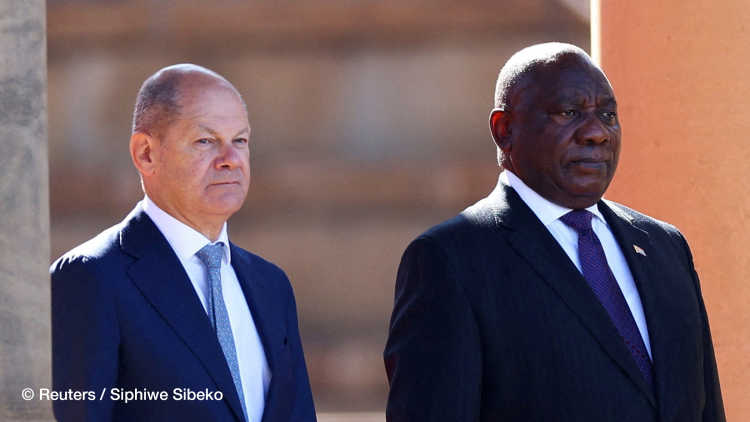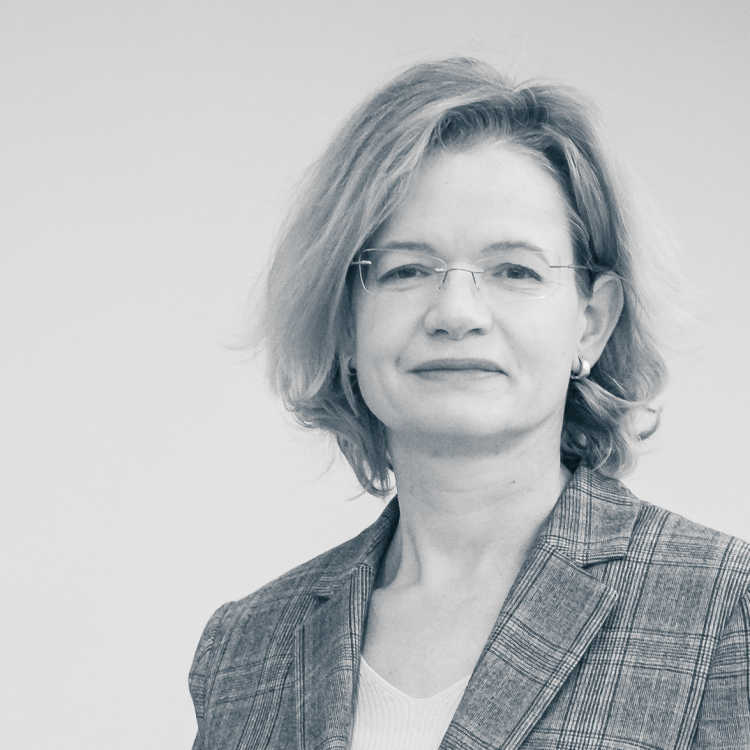- Startseite
- Publikationen
- GIGA Focus
- The Russian War against Ukraine: Middle East Food Security at Risk
GIGA Focus Nahost
The Russian War against Ukraine: Middle East Food Security at Risk
Nummer 2 | 2022 | ISSN: 1862-3611

As a region, the Middle East and North Africa (MENA) is the world’s largest grain importer. Approximately 30 per cent of global exports of wheat and barley, 20 per cent of corn, and a whopping three-quarters of sunflower oil come from Ukraine and Russia. The aggression against Ukraine is thus disrupting global food trade and affecting food security in the MENA. The war is also raising questions about future food systems and their water footprint.
In the Arab world, dependence on Ukraine and Russia for imports of wheat, the world’s largest source of calories, is at 50 per cent – among the highest globally. The greatest vulnerability exists in Egypt, Lebanon, and Sudan. Imports will actually need to rise from pre-war levels if population growth and dietary changes towards meat and dairy products are taken into consideration.
For lack of water, food self-sufficiency is not an option in the MENA. Food imports constitute “virtual water” – that is, the water used to produce a commodity and thus embedded in it. Virtual water can be imported by MENA countries via the food trade and has mitigated water scarcity by adding a “second Nile River” to the region’s water balance.
The global food crisis of 2007/2008 spurred MENA countries to attempt to alleviate their import vulnerabilities bilaterally, via investments in land and in value chains, but reliance on the multilateral international trading system remains. The reaction to the current crisis can build on lessons learnt since then, with coping capacities unevenly distributed between the region’s richer oil exporters and poorer countries.
Policy Implications
Avoiding new export restrictions such as those that occurred during the global food crisis of 2007/2008 is crucial. Western attempts to stabilise the multilateral food trade could help the MENA to source alternative supplies. This might also offer an opportunity to mend fences between the West and MENA at a time when closer energy cooperation is essential and an ambivalent stance in the MENA towards Russia has caused irritation in the West.
The Importance of Ukraine and Russia for Food Production
The Russian invasion of Ukraine is disrupting a global food trade that has been moving towards an ever-greater globalisation and corporatisation of value chains since the 1970s. The MENA region will be affected by this in major ways. It is the largest grain-importing region in the world, and food self-sufficiency is not an option for lack of water. The memories of the global food crisis of 2007/2008 still loom large in the MENA, when agricultural-exporting nations such as Argentina, Russia, and Vietnam declared trade restrictions out of fear for their own food security. More recently, the supply chain disruptions following the COVID-19 pandemic have intensified concerns about the reliability of the multilateral food-trading regime that emerged after World War II (Woertz 2020). The impact of the Russian war on Ukraine will be substantial. Over the past two decades, both Russia and Ukraine have developed into major grain exporters, similar to their roles in the nineteenth century. At that time, Black Sea grains constituted approximately 22 per cent of global exports, and the closure of the Dardanelles in World War I caused wheat prices in Chicago to jump by almost half (WFP 2022). By the 1970s, the Soviet Union had turned into a major grain importer, and the United States sought to leverage that vulnerability by declaring a grain embargo in the wake of the Afghanistan invasion. Today, Russia and Ukraine are export powerhouses again: approximately 30 per cent of global exports of wheat and barley, 20 per cent of corn, and a whopping three-quarters of sunflower oil come from the two countries. In the Arab world, dependence on Ukraine and Russia for imports of wheat, the world’s largest source of calories, is higher still, at 50 per cent. The greatest vulnerability exists in Egypt, Lebanon, and Sudan (see Figure 1).
Figure 1. Share of Russian and Ukrainian Wheat Imports in the MENA (2020, in %)

Source: Arab Reform Initiative 2022.
Note: The “Arab world” comprises the larger share of the MENA; the latter also includes Iran, Turkey, and Israel.
The impacts are multilayered. Harvest failure and manpower shortages reduce production. The most productive grain areas of Ukraine are in the east of the country where most of the fighting is taking place. Based on an analysis of satellite imagery, consultancy firm Kayrros expects that Ukraine’s wheat harvest could decline by at least 35 per cent this year. The logistics are disrupted with Ukrainian Black Sea ports such as Odessa closed. Both Russia and Ukraine have already declared export restrictions to ensure their own food security (Benton et al. 2022). Even if Russia were willing to maintain exports, financial sanctions will still limit the availability of trade finance, and the heightened risk will be reflected in higher insurance premiums. Transaction costs will soar. Production elsewhere is affected as well, since both Russia and Ukraine are major exporters of nitrogen, phosphates, and potassium fertilisers. Add to this the rising energy costs, and the inflationary impact on global food systems will be substantial.
MENA Food Trade Dependence and the Import of “Virtual Water”
The current situation evokes past spectres. The MENA is not only the world’s largest oil exporter, but also its largest importer of grains. The global food crisis of 2007/2008 hit MENA countries at a time when many of them had to downsize domestic agriculture. Aquifers had been depleted and local food production compromised local water security. Technical solutions such as drip irrigation can go only so far: if its efficiency gains are used to expand production, as happened in Morocco, so-called rebound effects can actually lead to increased water consumption as a result of the introduction of such irrigation (Jobbins et al. 2015). Agriculture is by far the largest water user in the region, with roughly 80 per cent of water withdrawal and over 90 per cent of consumptive water use (Allan, Keulertz, and Woertz 2015). There are notable differences; in the arid Gulf countries cereal import dependency is near total, having risen even more since Saudi Arabia decided to phase out its wheat production in 2008. More fertile countries such as Turkey, Egypt, and Syria produce some cereal, but not enough to cover all local needs. In Egypt, the largest wheat importer in the world, imports account for some 60 per cent of consumption. The water needs of cereal production also compete with the interests of a sizeable export industry in fruit and vegetables in countries such as Turkey, Tunisia, and Morocco. Turkey is among the ten largest agricultural economies in the world and the world’s largest producer of hazelnuts, apricots, figs, and cherries, to mention just a few (López, García-Álvarez-Coque, and Azcárate 2013).
Food self-sufficiency is not an option in the Middle East for lack of water, and climate change is negatively affecting domestic production potential. Food imports will actually need to rise if population growth and dietary changes towards meat and dairy products are taken into consideration. All this food trade constitutes “virtual water” that can be imported by MENA countries (Allan 2011). Virtual water describes the amount of water needed to produce a particular commodity, the water thus embedded in that commodity. Agriculture is by far the largest water consumer in the world, and approximately 70 per cent of global crops are produced with rainfed agriculture. The latter does not use the “blue water” of irrigation, but “green water” from rainfall that is encapsulated in the soil. Such green water cannot be metered, bottled, or shipped by pipeline. It does not figure in the global statistics about total renewable water reserves, which comprise only surface and groundwater. Yet green water is extremely important for global food security and for the import needs of food-deficient countries. By importing rainfed cereals from Brazil, Canada, France, Australia, Russia, or Ukraine, MENA countries effectively import the rainfall of other world regions and can benefit from it. Overall, virtual water has added a second Nile to the region’s water balance, as the late Tony Allan, the father of the virtual water paradigm, famously remarked (Allan 2003). Alongside Europe, Japan, and Mexico, MENA countries belong to the world’s largest net importers of virtual water, much of which they receive from agricultural exporters such as the United States, Brazil, India, and Australia.
Uneven Consequences across the MENA
Interruptions of trade flows today are hitting Middle Eastern countries unevenly, like during the global food crisis 2007/2008. With plenty of petrodollars in their pockets, Gulf countries could afford rising food prices then, but were still gravely concerned about the export restrictions of some agro-exporters and about reduced liquidity on international food markets (Woertz 2013). They reacted by increasing domestic storage and investing in their global supply chains. The state-owned Saudi Agricultural and Livestock Investment Company teamed up with international grain trader Bunge to buy a majority stake in the privatised Canadian Wheat Board, for example. Such investments in the downstream sectors of processing and distribution were much more consequential than controversial land investments in often food-insecure countries, such as Sudan or Ethiopia (Lay et al. 2021). The latter had a spotty implementation record and over a decade later, still do not provide a meaningful contribution to the Gulf countries’ food imports. The United Arab Emirates, for instance, has implemented a comprehensive food security strategy ranging from storage to price monitoring, as well as to the streamlining of domestic agriculture. In the wake of the COVID-19 pandemic, a special task force was formed to source alternative imports to adapt to supply chain disruptions (United Arab Emirates Government 2022).
Food diplomacy and management of value chains have been at the core of the Gulf countries’ food security strategy over the past decade in order to manage risks to food imports that are ultimately out of their control. This could also entail cooperation in multilateral bodies to make them more resilient and receptive to the interests of food importers. The World Trade Organization (WTO) is traditionally focused on trade liberalisation and import barriers, not export restrictions. During the Uruguay Round of trade liberalisation, net food-importing developing countries formed a negotiation alliance to lobby for affordable food imports (Narlikar 2003). We might see similar cooperation among vulnerable countries in the future, and MENA countries in the Gulf and beyond would be prime candidates for such alliances.
Even if richer countries of the MENA region managed to insulate themselves from direct impacts of the war, they would still be affected if food insecurity threatened political stability in the region. As energy exporters, Gulf countries can balance food inflation with rising oil revenues. Other countries in the region are in a less favourable fiscal position (Beck and Richter 2021). Yemen and Syria have been relying on food aid, and the World Food Programme faces challenges in sourcing supplies (WFP 2022). Egypt sources over 85 per cent of its wheat imports from the Black Sea region and will need to find an alternative. This will be more expensive and might necessitate recourse to external funding via the International Monetary Fund (Magdy and Martin 2022). The wheat from Russia and Ukraine is of lower quality and protein content than other internationally traded varieties, hence it is cheaper. There will also be competition for alternative supplies with other importers and vis-à-vis domestic needs in exporter nations. China might require more imports, as its Minister of Agriculture has warned of China’s “worst wheat crop in history” after rare heavy rainfalls last year delayed planting. After a streak of bumper harvests over the past five years, India has considerable wheat stocks, but its promises to “feed the world” and mitigate the food supply bottlenecks that the Ukraine war has caused have been overly optimistic. Heavy droughts will reduce India’s harvest this year, and it has announced export restrictions after facing domestic pressures to tame food inflation at home. Egyptian traders scouting for supplies have been left disappointed. France’s wheat harvest will also be affected by drought this year. The United States, Canada, Argentina, and Brazil might hold more promise for Egypt and others.
Maintaining Multilateral Food Trade
Compared to the global food crisis in 2007/2008, the world has entered the current crisis with a more favourable stocks-to-use ratio for wheat. This leaves some time to react and adapt as such stocks are drawn down. By the time Russia invaded Ukraine, the global wheat harvest for 2022 was already planted. It cannot be increased on a whim and on short notice. However, going into 2023 a more forceful market reaction to the price increases of the Ukraine crisis is to be expected, especially if it is accompanied by political support measures for farmers to provide finance, increase planted acreage, and secure input provision.
The reaction of MENA countries to Russia’s invasion of Ukraine has been subdued and fallen short of the rotund condemnation Western countries might have hoped for. The United Arab Emirates even abstained in the UN Security Council vote condemning the Russian aggression. The region’s oil exporters are keen to preserve the OPEC+ deal they have struck with Russia, and Putin’s demeanour and style is not without allure for fellow authoritarian strongmen in the region. Frustration with past Western interventions in the region runs deep in the Arab street. Many feel that the West that supported an illegitimate war of aggression against Iraq in 2003 without a UN Security Council mandate is getting a taste of its own medicine in Ukraine.
Against this backdrop, Western food trade and diplomacy is crucial to maintaining food security in the MENA and beyond. It offers an opportunity to heal past rifts, but also to remind the region’s leaders of one’s own interests and what could be expected in return. Maintaining the multilateral food-trading system by avoiding the kind of export restrictions that occurred during the global food crisis of 2007/2008 is an urgent requirement. It should be an area of priority concern for the European Union and other Western countries, as well as for multilateral bodies such as the WTO and the UN’s Food and Agriculture Organization and initiatives such as the Agricultural Market Information System launched by the G20 in reaction to the global food crisis of 2007/2008 in an effort to increase market transparency and reliability.
Fußnoten
Literatur
Allan, Tony (2011), Virtual Water: Tackling the Threat to Our Planet’s Most Precious Resource, London: I. B. Tauris.
Allan, John Anthony (2003), Virtual Water – the Water, Food, and Trade Nexus: Useful Concept or Misleading Metaphor?, in: Water International, 28, 1, 4–11, accessed 10 May 2022.
Allan, Tony, Martin Keulertz, and Eckart Woertz (2015), The Water–Food–Energy Nexus: An Introduction to Nexus Concepts and Some Conceptual and Operational Problems, in: International Journal of Water Resources Development, 31, 3, 301–311. Arab Reform Initiative (2022), The Impact of the Ukraine War on the Arab Region: Food Insecurity in an Already Vulnerable Context, accessed 10 May 2022. Beck, Martin, and Thomas Richter (2021), Oil and the Political Economy in the Middle East: Post-2014 Adjustment Policies of the Arab Gulf and Beyond, Manchester: Manchester University Press.
Benton, Tim, Antony Froggatt, Laura Wellesley, Owen Graham, Richard King, Neil Morisetti, James Nixey, and Patrick Schröder (2022), The Ukraine War and Threats to Food and Energy Security: Cascading Risks from Rising Prices and Supply Disruptions, London: Chatham House, 13 April, accessed 13 May 2022.
Jobbins, Guy, Jack Kalpakian, Abdelouahid Chriyaa, Ahmed Legrouri, and El Houssine El Mzouri (2015), To What End? Drip Irrigation and the Water–Energy–Food Nexus in Morocco, in: International Journal of Water Resources Development, 31, 3, 393–406. Lay, Jann, Ward Anseeuw, Sandra Eckert, Insa Flachsbarth, Christoph Kubitza, Kerstin Nolte, and Markus Giger (2021), Taking Stock of the Global Land Rush: Few Development Benefits, Many Human and Environmental Risks. Analytical Report III, Centre for Development and Environment, University of Bern, Centre de coopération internationale en recherche agronomique pour le développement, German Institute for Global and Area Studies, University of Pretoria, Bern, Montpellier, Hamburg, Pretoria: Bern Open Publishing. López, Raúl Compés, José-María García-Álvarez-Coque, and Tomás García Azcárate (2013), EU-Mediterranean Relations in the Field of Agriculture: The Example of Morocco and Turkey, 18 April, Paris: Notre Europe-Jaques Delors Institute, accessed 13 May 2022. Magdy, Mirette, and Eric Martin (2022), Egypt in IMF Talks on Possible Funding Amid War Pressures, in: Bloomberg, accessed 10 May 2022.
Narlikar, Amrita (2003), International Trade and Developing Countries: Bargaining Coalitions in the GATT and WTO. RIPE Series in Global Political Economy, London, New York: Routledge. United Arab Emirates Government (2022), Food Security, accessed 10 May 2022. WFP (2022), Food Security Implications of the Ukraine Conflict, 11 March, Rome, accessed 13 May 2022. Woertz, Eckart (2020), Wither the Self-Sufficiency Illusion? Food Security in Arab Gulf States and the Impact of COVID-19, in: Food Security, 12, 4, 757–760. Woertz, Eckart (2013), Oil for Food. The Global Food Crisis and the Middle East, Oxford, New York: Oxford University Press.
Gesamtredaktion GIGA Focus
Redaktion GIGA Focus Nahost
Lektorat GIGA Focus Nahost
Regionalinstitute
Forschungsschwerpunkte
Wie man diesen Artikel zitiert
Woertz, Eckart (2022), The Russian War against Ukraine: Middle East Food Security at Risk, GIGA Focus Nahost, 2, Hamburg: German Institute for Global and Area Studies (GIGA), https://doi.org/10.57671/gfme-22022
Impressum
Der GIGA Focus ist eine Open-Access-Publikation. Sie kann kostenfrei im Internet gelesen und heruntergeladen werden unter www.giga-hamburg.de/de/publikationen/giga-focus und darf gemäß den Bedingungen der Creative-Commons-Lizenz Attribution-No Derivative Works 3.0 frei vervielfältigt, verbreitet und öffentlich zugänglich gemacht werden. Dies umfasst insbesondere: korrekte Angabe der Erstveröffentlichung als GIGA Focus, keine Bearbeitung oder Kürzung.
Das German Institute for Global and Area Studies (GIGA) – Leibniz-Institut für Globale und Regionale Studien in Hamburg gibt Focus-Reihen zu Afrika, Asien, Lateinamerika, Nahost und zu globalen Fragen heraus. Der GIGA Focus wird vom GIGA redaktionell gestaltet. Die vertretenen Auffassungen stellen die der Autorinnen und Autoren und nicht unbedingt die des Instituts dar. Die Verfassenden sind für den Inhalt ihrer Beiträge verantwortlich. Irrtümer und Auslassungen bleiben vorbehalten. Das GIGA und die Autorinnen und Autoren haften nicht für Richtigkeit und Vollständigkeit oder für Konsequenzen, die sich aus der Nutzung der bereitgestellten Informationen ergeben.































